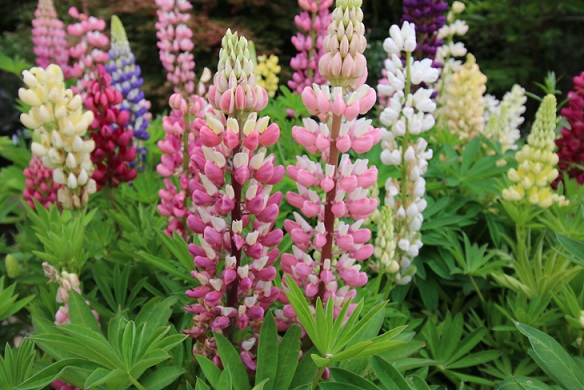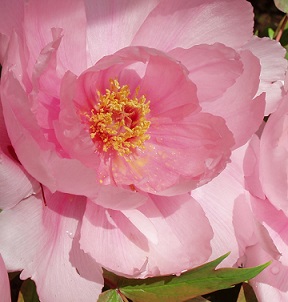Learn all about Perennial Plants
Perennials
are versatile, beautiful and important to the landscaping industry as
well as the nurseries that grow and supply them. Perennials
are very popular with gardeners mainly because in this group of plants
you will discover the toughest and yet most beautiful examples of
garden plants. There are opportunities in this field for knowledgeable
people with a passion for perennials, to propagate, grow and advise
clients on their cultural requirements and how to use them in their
gardens or public parks.
Perennials come in all forms,
from herbaceous plants that die down in the winter and re-emerge in
spring (year after year), to plants that retain their soft-stemmed leafy
growth year round. Although beautiful, many perennials are also tough
and very much adapted to a variety of climates - ranging from very dry
to wet. Some have colourful foliage as well as beautiful flowers, others
add architectural interest - but all add excitement and diversity to
the landscape or garden as they burst into flower each year.
Discover
what perennials are, which perennial plants are most popular today,
their cultural requirements (i.e. feeding, watering, soil requirements,
pruning, pest control), and learn how to use them to create beautiful
landscapes. A course equally valuable to landscapers, nurserymen, cut
flower growers and garden enthusiasts.
- Learn to identify and grow over 100 different perennials
- Pursue a passion, grow your plant knowledge, work with perennials
- Design colourful perennial gardens and flower borders
"This course will give you the opportunity to become an expert in
this field. Perennials are gaining popularity - many are dry garden
tolerant and as a result many people are showing an interest in growing
and learning about such a diverse range of plant species. A great fully
rounded course covering diverse aspects of plant growing." - Gavin Cole B.Sc., Psych.Cert., Cert.Garden Design, MACA, ACS Tutor.

COURSE STRUCTURE
Lesson 1. Introduction
- Review of the system of plant identification
- Physiology
- Information sources
Lesson 2. Culture
- Planting
- Staking
- Mulching
- Watering
- Feeding
- Pruning, etc.
Lesson 3. Propagation and Hybridization
- Seed
- Pricking out seedlings
- Cuttings
- Factors affecting cutting strike
- Propagating media
- Types of cuttings
- Hardening off young plants
- Division
- Separation
- Layering
- Potting mixes
- Potting up
Lesson 4. Review of Major Types of Perennials
- Herbaceous perennials
- Establishing herbaceous plants
- Popular bulbs, corms and tubers
- Supporting herbaceous plants
- Herbs in a perennial border
- Wildflower meadows
- Maintaining herbaceous borders
- Perennials for different purposes/uses
- Artemisia
- Lavandula
- Scented Geraniums
- Ornamental; grasses
- Bamboos
Lesson 5. Pests and Disease Plant pathology
- Parasitic and non parasitic problems
- Conducting an inspection and identifying problems
- Tell tale symptoms
- Common terminology
- Common pests on perennials and their management
- Diseases
Lesson 6. Irrigation and Hydroponic Culture Techniques
- Significance of water
- Infiltration and water retention
- Water needs for perennials
- Watering methods
- When to water
- Testing water needs
- Reducing water needs
- Watering perennials in pots
- Drip irrigation
- Hydroponics Introduction
- Types of hydroponic systems
Lesson 7. Landscaping with Perennials
- Designing the garden
- Landscape principles and components
- Landscape effects
- Design styles
- Flower bed design
- Colour themes
- Cottage gardens
- What perennials to grow in cottage gardens
- Scented plants
- Landscaping with bulbs
Lesson 8. Further Uses for Perennials
- Cut Flowers
- What flowers the longest
- Harvest and storage
- Growing Carnations
- Chrysanthemums
- Herbs
- Herb crafts
Each lesson culminates in an assignment which is submitted to the
school, marked by the school's tutors and returned to you with any
relevant suggestions, comments, and if necessary, extra reading.
Course Duration: 100 hours of self paced study

What are Herbaceous Perennials?
Botanically speaking, a perennial is any plant that lives for more than one or two years. This includes trees and woody shrubs, but most gardeners think of perennials as small flowering shrubs such as geraniums and Marguerite daisies, and herbaceous soft-wooded plants that die back each winter, such as hellebores, campanulas and aquilegias.
Herbaceous is a general term to describe those plants that do not have woody growth. Some herbaceous plants retain their foliage all year and many others have a period of dormancy. These plants often store food in a part of the plant below the ground. They include bulbs, corms, tubers and rhizomes. Plants like these provide some of our most spectacular flowering displays. Some are very fragrant, many others are not..
Herbaceous perennial plants can be used to create a number of different landscaping effects:
- Planted in single varieties in massed beds for a formal appearance.
- Interspersed with other plants in the garden bed in clumps or drifts for an informal effect.
- Planted under deciduous trees in random groups to create a naturalised 'wild' garden effect.
When selecting herbaceous plants, consider how they will look all year round. For many months, they will be dormant and unseen. They also need to be left to die back after flowering, when they can often look unattractive. To be grown at their best herbaceous plants require careful maintenance.
Perennial displays use a great deal of water and nutrients hence soil conditions need to be the very best at all times. Some do like shade but the majority prefer sunny positions.

Consider the Site
Does it have any particular problems which should be treated?
- Hard clay soils need to be loosened – you can do this through cultivation (digging), by adding soil conditioners such as gypsum (as appropriate), or by incorporating organic matter such as well rotted manures and compost.
- Sandy soils can dry out too easily or be low in nutrients - overcome these problems by adding well-rotted manures or compost, or wetting agents. Add generous amounts regularly to maintain structure, water-holding capacity, and fertility.
Check the soil’s pH level (the degree of acidity or alkalinity). Simple test kits are readily obtained from nurseries, garden centres, or other suppliers. Most plants prefer a slightly acid or neutral soil (pH of about 6 to 7). Most perennials tend to be very adaptable to pH and will still grow well in pH levels just outside this range.
Once you know your soil’s pH you can either choose plants that like the pH of your soil/growing media (this is the best option), or you might alter the pH to suit the plants you wish to grow. The pH level can be raised by the addition of lime, or lowered through the addition of acidifying materials such as manures, sulphate of ammonia, or sulphur powder.
On exposed sites, it may be necessary to provide windbreaks or to channel wind with fences or planting. Planting protects tender plants but still ensures good ventilation. Be careful though, if the garden is totally enclosed air movement is restricted and that can result in an increase in diseases.
All weeds should also be removed from the site prior to planting. If you use weed killers then there will also be a waiting period before the soil is safe to use.
For shady sites, select plants to grow that prefer, or will tolerate, periods of shade. You can always find suitable shade-tolerant plants to fit in with a planting scheme or garden design.
Use Healthy Plants
Healthy plants are more likely to resist damage from pests and diseases, and more likely to recover if they are attacked. The roots and top growth of the plant should be well developed. There should be no deformed growths (e.g. twisted, distorted leaves, swellings on roots). Avoid plants with badly marked leaves. Unusual growth patterns can indicate a genetic deformity, viral or bacterial infection, or perhaps represent evidence that the plant has been poorly nurtured. A plant with unhealthy growth is less likely to thrive. Seeds and bulbs should also be fresh and free of abnormal markings, or any rots.